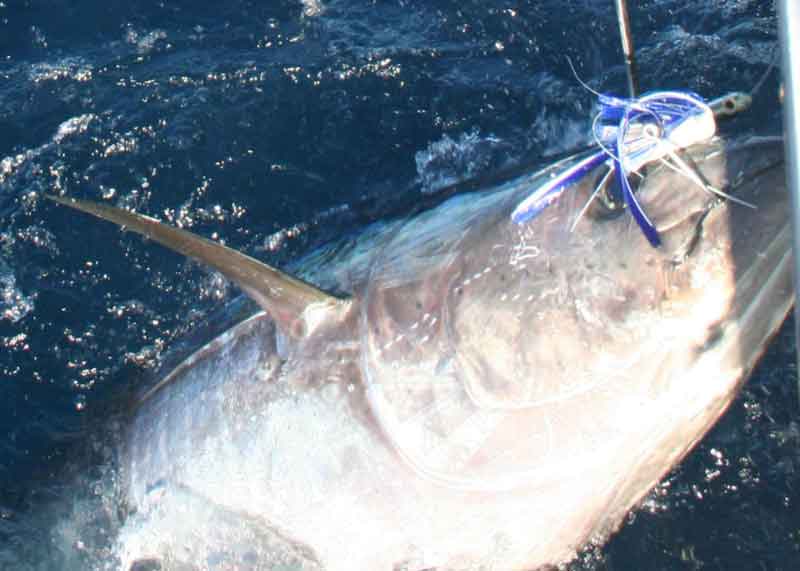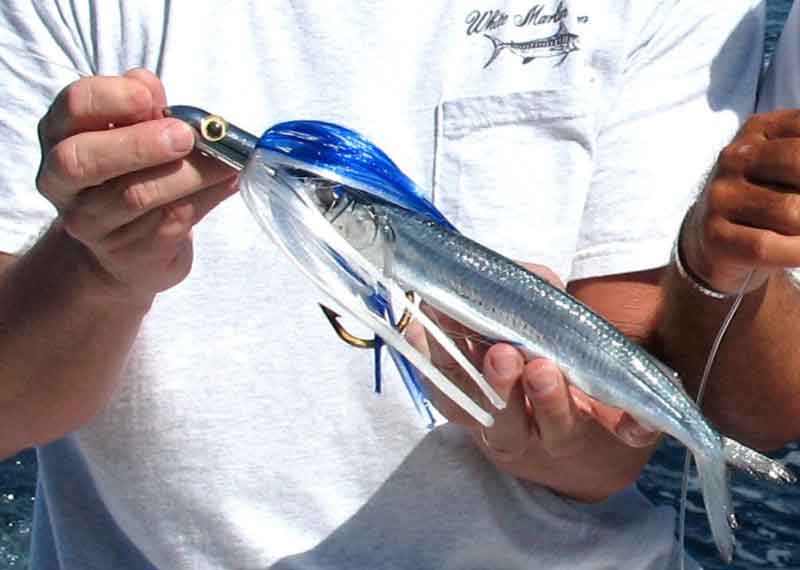In case you missed Top Rigs for Tuna Part I last month, we discussed constructing a bird/green machine tuna rig. That rig utterly destroys the tuna, but even so, the number-one top trolled bait on the east coast is rigged ballyhoo. This versatile bait can be trolled naked, skirted, rigged to skip on the water, or to swim under the surface. And while tuna certainly eat naked ballyhoo, most of the charter fleet skirts their ballyhoo when tuna fishing, offering an endless variety of color possibilities.

Studies of tuna eyes indicate they have at least one cone that should be able to detect color wavelengths. What colors can they see? Nobody knows for sure. But anglers who spend a lot of time offshore chasing tuna soon learn they often have a preference for certain colors, and that preference can change from day to day. As a result, various colored skirts will be found in every charter’s cockpit rigging area. However, there is one lure that stands head and shoulders above the rest for skirting when targeting tuna, and that is an 8.25-inch Iland IL400 in blue/white. Seldom is a spread set in the charter fleet that does not contain this offering. It catches everything swimming, and hungry tuna find it close to irresistible when skirted over a medium bally. If big bluefin are around, use it to skirt horse ballyhoo to provide a larger offering. This rig is also just the ticket for blue marlin in the deep, quite often.
Newcomers to offshore fishing are often hesitant to rig ballyhoo. But there is no need to buy expensive pre-rigged bally. Rigging a ‘hoo behind a blue/white Illander is fairly simple, when keeping a few tips in mind:
- Regardless of rigging method, the ballyhoo needs to look natural when trolled. That means it should appear to be swimming, not spinning or turning on side. This is accomplished by “popping” the scales along the backbone, which makes the ballyhoo flexible. Place your index finger and thumb on the back of the fish and squeeze hard enough for the top rows of scales along the fish’s back to pop up. Start just behind the fish’s head, and work your way all the way back to the tail.
- If the bally have been salted down after rigging they will initially be stiff, but once wet, will limber up and swim. Salting down is a great option for skirted bally as it greatly increases longevity. However, quality frozen ballyhoo with clear eyes and no freezer burn have no issue providing an hour of more of trolling (depending on speed and presentation) before needing replacement. Regardless, always lower a ballyhoo over the side and watch it before setting a line, to be 100-percent sure it’s swimming naturally. If it’s not, pull it back in and try to limber up the fish a bit more and/or adjust the rigging, until it’s swimming properly.
- The hook needs to be centered in the stomach of the ballyhoo when rigging, not inserted high near the backbone. A hook placement with a low center of gravity reduces the amount of weight necessary when rigging. If the hook is off-center, the ballyhoo will lean to the right or left. Also, the hook must “float” in the body cavity. The bait should be pulled from the front where the eye of the hook is secured, not with tension against the stomach where the hook punches through.
- Then there are fins. Bally often have a fin sticking out away from the body. This again may cause it to swim on its side or at an angle. If this is the case, grab some scissors and cut the fins off. When test-running a rigged ballyhoo next to the boat. If they do not swim correctly, keep making adjustments or simply rig another – a bally spinning or running sideways significantly reduces your chances for success.
- When it comes to the chin weight use the least amount or lead possible; slower trolling speeds require less weight. As a rule of thumb, dink ballyhoo need a quarter to half an ounce, mediums get a half to three-quarters, and select/horse may need an ounce. When you’re first learning to rig, using a slightly heavier egg sinker will help keep the bait vertical. Even when skirted, use a chin weight so the ballyhoo runs correctly and does not turn on its side within the skirt.

And always make sure you have a blue/white Ilander IL400 ballyhoo rig in the mix. It certainly does not guarantee a bloody deck, but it just as certainly increases your chances of getting a tuna on the line.
For more rigging tips check out John Unkart’s books Offshore Pursuit and Saltwater Tales, available on Amazon.